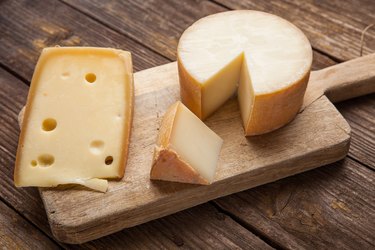
In North America, "Swiss" cheese doesn't necessarily refer to cheese that comes from Switzerland. Rather, it's a homegrown variety inspired by Emmental, a cheese that does originate in Switzerland. Both the original and American versions have a mild flavor and signature holes.
Gruyere is also a Swiss cheese in the sense that it originates in Switzerland. However, it is its own variety distinct from Emmental-style Swiss cheese and doesn't typically have holes. Gruyere cheese and American Swiss cheese (and authentic Emmental) have many characteristics in common, including being excellent for melting. Use them interchangeably in recipes.
Video of the Day
Video of the Day
Swiss and Gruyere Cheese Shared Heritage
American Swiss cheese is inspired by Emmental, a cheese with a long heritage in western Switzerland. Emmental is traditionally made from raw cow's milk, is formed into enormous wheels weighing around 160 pounds and is aged in caves (or cellars in modern times) for four months to over 14 months.
Cheese that is labeled "Swiss" in North America might be mass produced or artisanal, aged or young and unlike authentic Emmental, it is made using pasteurized milk rather than raw milk. Baby Swiss and lacy Swiss are two versions of Swiss cheese created in the United States.
Gruyere, a protected name in Switzerland and the European Union, originates in the region of Gruyere in western Switzerland, where it has been produced since the 12th century. Local regulations require Gruyere to be produced from local raw milk and aged for a minimum of five months. It's produced in wheels of around 50 to 90 pounds, matured in a cave (or cellar) for five to 18 or more months and brushed with brine to form a brownish, grainy rind. Many countries outside of Switzerland, including the U.S., produce their own Gruyere-style cheeses with similar characteristics.
Characteristics of Swiss and Gruyere
American Swiss cheese and Gruyere cheese are very similar in appearance, flavor, texture and culinary applications, but there are some key differences between the two.
Appearance:
Both Swiss and Gruyere are ivory to pale yellow in color. Swiss is characterized by its holes, which in the U.S. are regulated to have a maximum size that is typically smaller than those in authentic Emmental. Gruyere does not usually have holes, but there are sometimes cracks in older cheeses. Gruyere has a thin, brownish-colored rind that is edible though tough, whereas Swiss does not have a rind.
Texture:
Swiss and Gruyere are semi-hard cheeses as a result of being pressed during production. They're both smooth and firm to the touch and do not crumble. American Swiss cheese is usually firmer than authentic Emmental. Both excel as melting cheeses, turning soft and oozy without becoming greasy, rubbery or grainy.
Flavor:
Swiss and Gruyere cheeses both have a mild, nutty and slightly sweet flavor that becomes more intense with age. In general, Gruyere has a stronger flavor than Swiss, but this difference might be mitigated by age differences. American Swiss cheese is typically less flavorful than Emmental. The aroma of both cheeses tends to be mild, becoming more noticeable with age.
Gruyere vs. Swiss Cheese Nutrition
Gruyere and American Swiss cheeses have almost identical nutritional profiles. Gruyere has 117 calories per ounce compared to 112 calories per ounce for Swiss. Both average 9 grams of fat per ounce. Gruyere is slightly higher in protein, with 8.5 grams per ounce compared to 7.7 grams per ounce for Swiss.
Gruyere also has slightly more calcium and potassium than Swiss. The only significant nutritional difference between the two cheeses is in sodium level: Gruyere has 202.8 milligrams of sodium per ounce compared to 53.1 milligrams in an ounce of Swiss.
Delicious Uses for Swiss and Gruyere
Given their similarity in characteristics, it's not surprising that Swiss and Gruyere cheeses are interchangeable in culinary applications. Enjoy both cheeses sliced or cubed with crackers or crusty bread and in sandwiches and salads. Swiss cheese is a classic ingredient in Reuben and Cubano sandwiches. Gruyere features in a croque monsieur, in souffles and on top of French onion soup.
A classic fondue blends both cheeses together. Try both on cheeseburgers, in cheese sauces and dips and in pasta dishes, omelets and gratins. Both cheeses are ideal for baked goods such as cheese scones, pinwheels and cheese straws.